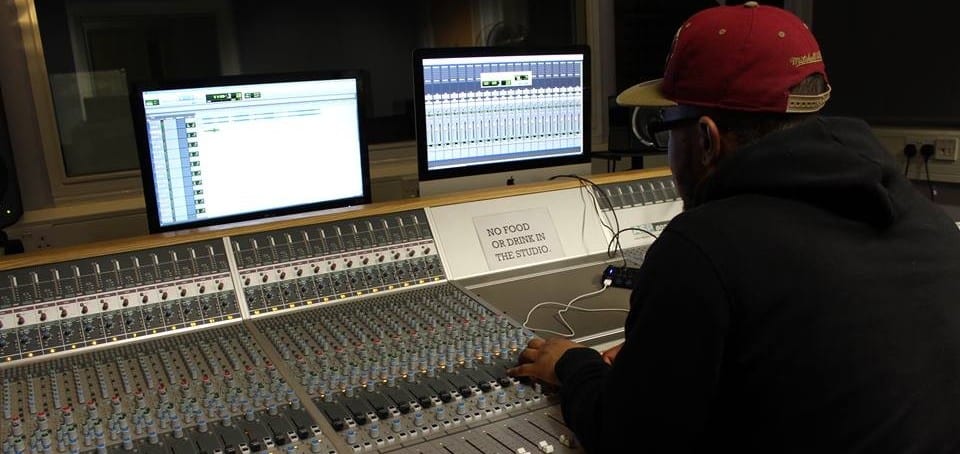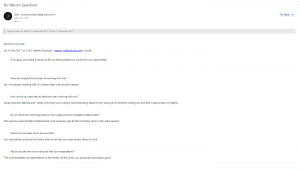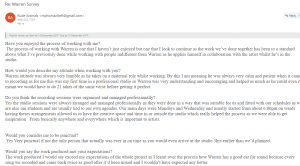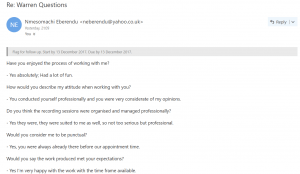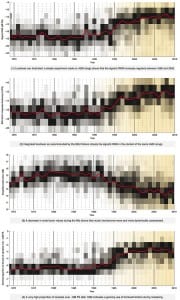How have I used professional practices to successfully collaborate with vocalists and session players?
Throughout the course of this project I have worked with four different artists . From my research carried out on professional practices I have made sure my communication, punctuality and work ethic fall in line with what is to be expected within this industry. After working with each artist, I asked them to answer a few questions for me as a testimonial to see whether I have successfully used professional practices when I have been collaborating with them.
From looking at these testimonials I believe I have successfully met learning outcome one.
How have I incorporated key production techniques used by Rick Rubin in the production of Yeezus into your audio project?
The first track I have produced based of the production techniques used by Rick Rubin on Kanye West’s album Yeezus is called “Rage”. Although I referenced the album in its entirety I focused particularly on the track “Black Skinhead”. The mix of this song is very loud and in your face and I tried to recreate this in “Rage”. From my research on Rick Rubin I have learnt how he runs his sessions. In an interview with Zane Lowe (BBC Radio One) he said “The goal is to create a setting where an artist can be completely vulnerable…. completely free to be themselves”. From looking at the testimonials from the artists shown earlier I would say I created a very positive work environment and allowed them to be the best artist they could be. In terms of aesthetic of sound I have shown that Rick Rubin likes to strip back a lot of the production and provide the listener with the closest thing to a live performance, I believe I have achieved this in “Rage”. I believe I have met learning outcome two.
How have I incorporated key production techniques used by Mike Dean in the production of Birds In The Trap Sing Mcknight?
My second track called “One Take” is based on the production techniques Mike Dean used on Travis Scott’s album Birds in The Trap Sing McKnight. I have referenced the song “Pick Up the Phone Ft.Quavo”. Although the two songs are different musically/sonically, I wished to capture that same level of energy in my mix and make sure the listeners attention was firmly on the MC. From my research I identified that Mike Dean has a minimalist approach to mixing therefore, I have done minimal automation on the instrumental and used minimal production techniques, I didn’t wish to take attention away from the MC and wanted the track to sound as raw and authentic as possible. In an interview with Dave Pensado he said, “If you have something in your song you didn’t turn up loud you should turn it off”. I have incorporated this ideology into my mix of One Take, this song has no hook and is all about the artist showing off his ability as an MC, I pushed my mastering plugin’s threshold as high as it would go without distorting (-9.0dB) this allowed me to make the song as loud as possible. I believe I have met learning outcome three.
How have I incorporated key production techniques used by Jeff Ellis in the production of Channel Orange?
The track I have produced inspired by the production techniques of Jeff Ellis is called “Oceans”. I referenced the song “Pink Matter Ft Andre 3000”. I attempted to imitate the overall “vibe” of this song and integrate my own production style. To produce Channel Orange Jeff Ellis, initially used a Neuman u87 to record Frank Oceans voice. Using the Neuman u87 available in media loans I copied this process. Jeff Ellis’s mixing process was one of the most interesting things I have learned about this project and this is something I tried to imitate in my work. For example, when mixing Frank Ocean’s vocals, he leaves a lot of the low-end frequencies in (chest voice) because he describes it as emotional. I copied this technique when mixing the rapper’s vocals on “Oceans” and I believe it added a more emotional element to their voice. Another thing Jeff Ellis does when mixing is see how well his mixes translate on a wide range of systems including MacBook speakers, Beats by Dre and low-quality speakers. When mixing “Oceans”, I often listened to how well my mix translated on the mono cube in the Multitrack studio and on my own Beats by Dre. These different listening environments affected the final mix of “Oceans”. I believe I have met learning outcome four.
How have I incorporated key production techniques used by Young Guru in the production of The Blueprint 3?
The track I have produced inspired by the production techniques of Young Guru is called “Day after day”. I referenced the song “Empire state of Mind Ft Alicia Keys” present on The Blueprint 3 when creating “Day after day”. I produced “Day after Day” as a pop record that has been constructed in a Hip-Hop way. During the production of The Blueprint 3 Young Guru used a Neuman u87 . I copied this process and used a Neuman u87 to record my female vocalists. Young Guru also ran Jay-Z’s vocals through the Avaleon 737 compressor. Unfortunately, I could not replicate this because I had no means of accessing an Avaleon. However, I did run my tracked vocals through the Chameleon 7720 compressor available in the Multitrack studio, this was the closest replica of the Avaleon’s sound I could create with the tools available to me. Much like Young Guru I also mixed the instrumental to “Day after day” first and exported all the stems to a new Pro Tools session where all the faders are set to zero. Finally, when mixing female vocals Young Guru talks about the 2000khz-300khz as the magic range and suggests that boosts are present in these areas, something I have also incorporated into the vocal mix of “Day after day”. I believe I have met learning outcome five.
I have enjoyed this audio project and I believe I have grown immensely as a producer, I have improved my technical skills in regards to mixing and I have also began to create a distinctive production style. I have also been able to work with artists in a professional setting allowing me to grow my portfolio. If I was to do this project again I would of ran more mixing sessions when the artist is present, this would allow for easier communication on their vision for their song and would speed up the creative/production process.
